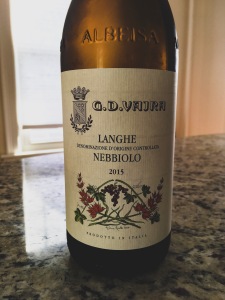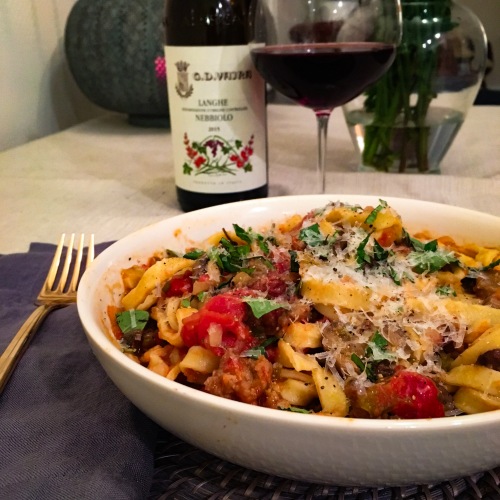Recently, NPR ran a story about the Danish concept of Hygge (“hue-gah”). Admittedly, I didn’t actually hear the story, but was told about it be someone who only wishes to be described as “The best person in the world” and “Incredibly sexy”, but nonetheless, it sparked both of our interests and some thorough Google research and execution of the concept soon followed. A quick definition of the word would be as difficult to do as defining Terroir for the wine world, but at its heart Hygge is a warm emotional connection to a moment. “Cozy” seems to come up a lot when describing it. However, the best found definition was found here. The current theory is that Hygge is responsible, or at least a large part of why the Danes are so happy according to people who measure that sort of thing. Naturally, those of us in Minnesota have been taken with the concept since Hygge is particularly an effective draw during our winter months. In other words, we view it as a way to stave off the impending madness that comes from the winter doldrums.
Some examples of Hyggelig (“hue-gah-lee”) things:
- Savoring a warm meal with someone while being basked in the candlelight.
- Curling up on the couch with your cup of morning coffee and reading a book.
- Enjoying the conversation of friends on a cold winter’s eve.
- Hearing your soft footsteps running on a trail in the snow.
Basically, Hygge, is what this blog is all about for those of us who are imbued with the world of wine. Interestingly enough, the other dovetail of Hygge and this blog (which I assume is the American national past time) is that it’s all about mental framing and priming. When an idea is framed, it is put in a certain context. This is like setting the boundaries of a debate topic, or when the media presents a story in a certain light; in a way, how you think about something is restricted by the parameters set forth. Priming on the other hand is presenting bits of information ahead of time that influence the direction your thought process goes down in the future. If you’re paranoid, you’d probably call this being brainwashed.

You will like this wine. Shhh, don’t talk, just drink.
Framing and priming are an integral part of the wine and food experience. We have expectations [framing] as to what a wine will taste like and if it meets or exceeds that expectation we will have a positive experience. If we just recently took a whiff of a particular herb and we notice an herbal smell in a wine, we are more likely to label that wine aroma with the herb we originally took a whiff of [priming]. This is why wine descriptors, although fun and sometimes poetic, are mostly bullshit, but I will have more to say about that in a future post. I have often been asked how I create wonderful experiences revolving around wine and food and to take away some of the shroud of mystery, it’s mostly that I am able to frame and prime people’s mental state in the way that I want for the experience I give them. Yes, I have a certain level of cooking ability and a knack for judging what wines various people will like with a meal, but if I just set a dish down with a glass of wine down and said “Here’s your dinner. Eat it alone.” the Hyggelig-ness (I just created that) of the situation would drop dramatically. So I put the lights down a little lower, set the music to match the mood (always have music), light some candles, point out aspects of the food and wine that I think go together well, and lo and behold; suddenly we’re having a good time.
Let’s take that clambake I did back in the summer as an example. If you tried to recreate that yourself, you could have gotten the exact same food and the exact same wine, but it could have really sucked as an experience for you if you ate it in a hurry in between doing errands or with a dog constantly barking at you, or perhaps you were just in a bad mood. You really have to linger in the experience to the point where it become intimate. Notice I didn’t say grand, opulent, or even fancy. Just intimate. Connected.
Anyway, tonight I will be creating some Hygge with a dish of pasta, chorizo, and chickpeas and most likely a darkly fruity red wine (Pro secret: you can generally enjoy any wine with any food as long as you like them both and make slight adjustments if necessary). I will wear my most Hygge heavy shawl sweater. The atmosphere will be set with a fire in the fireplace, some ambient candle light, the lights from the Christmas tree, and some music turned down low as the snow falls outside. Conversation will be enjoyable, and most importantly, the experience will be lingered over.

Hygge prep
As the Cranberries once asked: “Do you have to, do you have to, do you have to let in linger?” To that I say Yes, Cranberries, yes you have to let it linger. Therefore, I hope all of you, especially those of us in the wintry north and the shortest days, find some Hygge this winter.

Mega-Hygge candle
Read Full Post »
 Notes: Now that I live in Boston, I’m taking advantage of the major cultural staple of being able to walk into some market owned by an elderly Italian person and wish that they were your grandparent. For me, Tony’s Market, appropriately owned by a guy named Tony who is between 80 and 150 years old and is still making the sausages, is just down the street. Anyway, I wanted nothing more than to cook and drink some wine after being up since 3:30am that morning for a major system update for work and this really hit the spot. A comfort meal at it’s finest with a beautiful wine to boot. I originally planned to add a little heat in the form of red pepper flakes and either some clove or nutmeg, but I was on a severe lack of sleep so those accidentally got left out. Next time…
Notes: Now that I live in Boston, I’m taking advantage of the major cultural staple of being able to walk into some market owned by an elderly Italian person and wish that they were your grandparent. For me, Tony’s Market, appropriately owned by a guy named Tony who is between 80 and 150 years old and is still making the sausages, is just down the street. Anyway, I wanted nothing more than to cook and drink some wine after being up since 3:30am that morning for a major system update for work and this really hit the spot. A comfort meal at it’s finest with a beautiful wine to boot. I originally planned to add a little heat in the form of red pepper flakes and either some clove or nutmeg, but I was on a severe lack of sleep so those accidentally got left out. Next time…





